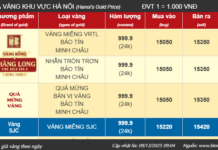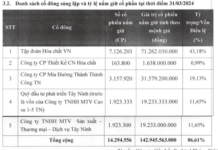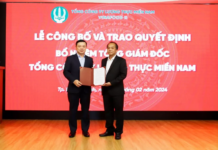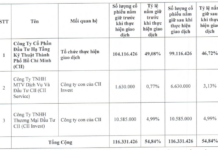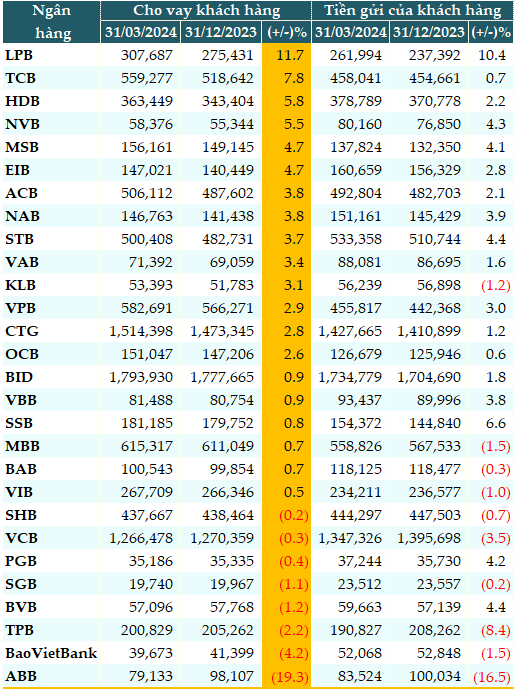The history of Vietnamese currency is a fascinating journey, and I had the privilege of speaking with Mr. Tran Tien, the artist behind the design of Vietnam’s polymer banknotes, to uncover some of its milestones. Mr. Tien, now in his golden years, welcomed me into his modest home, where a wall adorned with his banknote designs served as a daily reminder of the country’s historical milestones.
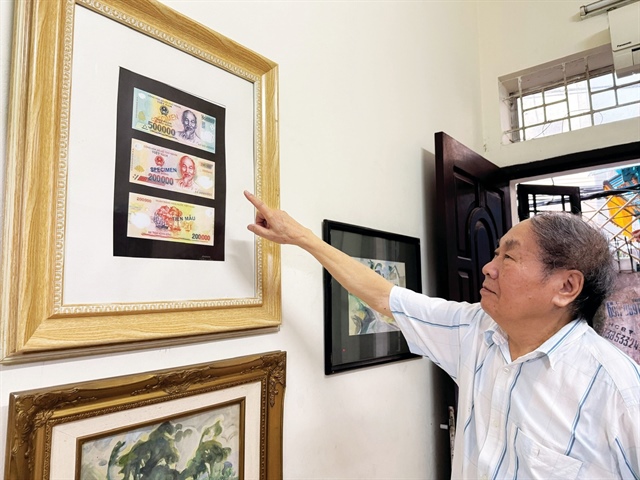 Mr. Tien proudly displays his polymer banknote designs. |
He carefully retrieved and shared with me a valuable yearbook chronicling the history of Vietnamese banknotes from 1945 to 2025, like a slow-motion film capturing the country’s pivotal moments. Accompanying this journey were the evolutionary steps in the country’s currency, showcasing improvements in aesthetics and quality, most notably across six banknote series.
Mr. Tien pointed out the first series, issued by the Ministry of Finance between 1946 and 1951, before the establishment of a central bank. Known as the “Finance Ministry Money,” it included the Finance Money, Southern Money, and Central Region Credit Notes.
The second series, from 1951 to 1958, featured improved printing and paper quality and was designed and printed abroad. The third series, used from 1959 to 1978, marked a new era of economic recovery, socialist construction, and the unification of the country after the liberation of the North and the end of the resistance war against France. This series was a significant step forward in standardization, incorporating intaglio printing and designed entirely by Vietnamese artists with support from foreign partners.
The fourth series, issued from 1978 to 1985, followed the liberation and unification of the country. It was known as the “Unification Money.” The fifth series, introduced in 1985, coincided with a period of severe economic challenges and hyperinflation, leading to a breakdown of the original denomination standards. This resulted in the issuance of new banknotes with lower quality to meet societal needs, alongside dozens of payment vouchers used as money.
The sixth and current series is the polymer banknotes. Introduced in 2003, these banknotes addressed the rampant issue of counterfeiting in the 1990s, posing a threat to the country’s economy. The polymer series has successfully met the goals of cleanliness, durability, and security, with advanced anti-counterfeiting features and improved mechanical processing, marking a new era in Vietnam’s banknote production technology.
Mr. Tien, a record-holder for designing numerous banknote designs, shared insights into his career. After graduating from the University of Fine Arts in 1975, he joined the State Bank of Vietnam’s design team and had to start anew due to the unique graphic language of currency design. Banknote design involves coordinating dozens of processes, including drawing, manual engraving, computer-aided design, plating, printing, and assembly.
“Designing currency is a highly technical profession, and there are no specialized schools for it,” Mr. Tien shared. “The skills and experience are usually passed down from one generation to the next or self-taught through the study of advanced printing technologies from around the world.”
In his nearly 30-year career, Mr. Tien has designed no fewer than 40 banknote samples, each representing a pinnacle of technological perfection. Compared to older banknotes, which relied heavily on intricate patterns to deter hand-drawn counterfeits, today’s banknotes leverage advanced technologies such as intaglio printing and optically variable ink. Artists designing Vietnamese currency are expected to creatively showcase the country’s unique beauty and cultural heritage, with the portrait of Uncle Ho being the only portrait featured on all banknotes.
Mr. Tien emphasized the intricate nature of banknote design, requiring the precision of a crime prevention expert and the ability to outsmart copying technologies. He explained that when designing the polymer banknotes, his team had to ensure compatibility with ATM machines and meet global standards. In the digital age, banknotes must also be designed to prevent reproduction through photocopying, color laser printing, or advanced counterfeiting techniques.
Mr. Tien and his team had been secretly researching polymer banknote design a decade before the government’s decision to replace the old cotton banknotes in 2003. He designed both sides of the 200,000 VND polymer banknote, the back of the 50,000 VND note, and the front of the 500,000 VND note. Higher denominations demand more sophisticated technology and intricate details to ensure security.
“The 500,000 VND banknote, for example, has hidden elements that can only be seen under an oil lamp or candlelight, revealing unique signatures, flowers, and numbers. This feature is impossible to replicate,” Mr. Tien explained.
After 22 years in circulation, the polymer banknotes have exceeded expectations. They are not only cleaner and more durable but also offer superior security and longevity, lasting four times longer than cotton banknotes. Mr. Tien proudly proclaimed that the polymer series is the best in Vietnam’s history, showcasing the country’s technological prowess on par with the world. He attributed this success to the collective effort of the team, including his own modest contribution.
|
“Compared to older banknotes, which relied heavily on intricate patterns to deter hand-drawn counterfeits, today’s banknotes leverage advanced technologies such as intaglio printing and optically variable ink. Artists designing Vietnamese currency are expected to creatively showcase the country’s unique beauty and cultural heritage, with the portrait of Uncle Ho being the only portrait featured on all banknotes.” – Tran Tien, Banknote Designer. |
Witness Vietnam’s Map Made of Money at the Country’s Achievements Exhibition
The Banking Industry Exhibition promises an extraordinary experience with a unique blend of light and currency. Marvel at the stunning light display, a rainbow of colors that illuminates the space, and be intrigued by the creative map of Vietnam, crafted entirely from genuine banknotes. This exhibition is set to captivate and inspire, offering a fresh and memorable take on the world of banking.
The Race for Saigon Square: An Insider’s Account
The forum’s narrative on intellectual property rights unveils a formidable ‘battle’ between regulatory authorities and the crackdown on counterfeits.










